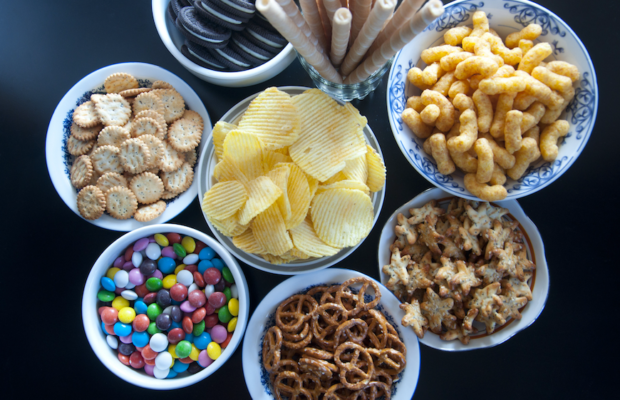Ultra-processed food fattening Americans

Ultra-processed foods are exactly what their name would suggest. Ultra processed foods have been put through the factory three times over. They have been put through so much processing that their molecular structure is all but completely destroyed. They no longer resemble anything remotely close to being natural, and they are fully restocked on store shelves every day.
The U.S. addiction to processed foods begins with the fact that consumers are often unaware of just what it is they are eating.
For example, take hotdogs. They are a staple of a summer evening and might taste pretty good, but once you know what’s in them, you are never able to look at one the same. Hotdogs are ultra-processed. The trimmings of beef and pork that the hotdogs are made are first ground into a fine mixture and then churned. After that, water is added, followed by a variety of seasonings and some salt. The hotdogs are then once again ground into basically a paste, before being stuffed inside of a cellulose casing to give the mixture shape. They are then baked, smoked, packaged and sent off to the consumer.
Hotdogs are a well known offender of being put through lots of processing, but they are far from the only ones. Many of these foods like to make references to the natural products from which they started, as a way to say that they are healthier, but they’re not.
Take the simple potato chip. It is nothing but a thin crispy piece of potato, right? Not exactly. The journey of Lay’s potato chip is a long one from the ground to a packaged bag. First, the potato is skinned, has its “eyes” poked out and is washed. After they dry, they are washed again, this time more thoroughly, to remove starch, and other parts of the potato. After this, the potatoes are blanched, a process of pre-cooking that prepares them to be baked or fried, and also removes more of the actual potato, leaving only extremely thin slices. The potato chip is next fried but removed before it is entirely done to be seasoned. After that the potato chip is baked in an oven to add that crisp crunch associated with the chip. Afterward, it is then taken out of the oven and covered with more seasonings, before being sent off to be covered in oil and salted, then finally, put in a bag.
The potato chip no longer seems so simple, but its molecular structure is. The molecular structure of the potato chip no longer resembles anything close to that of a potato. This is the case for almost all of these ultra-processed foods. All of the machinery, all of the reshaping, cooking, crunching and added ingredients turn the molecular structure of whatever they started with into a mess that is just trying to hold itself together.
But these molecular messes are consumed on a daily basis. Why? Probably because they taste good.
The purpose for all of the processing could be many things, but the one big reason will always be to alter the taste. Processed foods are made the way that they are specifically so that people will like them. The whole point is to make something that people will want to eat again, which is why so many extra ingredients are added, but most of these added ingredients simply aren’t healthy, and many people started to take notice.
It was at this point, in the mid 2010s, that companies started producing reduced fat versions of their normal products, but the fat in processed foods is usually what makes it taste good, so something had to replace it, and that something is sugar.
Sugar has been creeping its way into processed foods for the last decade, slowly replacing the fat that was removed, but it has reached unprecedented amounts. For context, the daily allotment of sugar for men is 36 grams, or 9 teaspoons. For women it is lower, only 25 grams, or 6 teaspoons of sugar, according to the FDA. One regular can of Coca-cola contains about 32 grams of added sugar. That is practically the entire daily allowance, in just one can.
There are a couple of problems with all this added sugar. The first is that your body processes sugar extremely quickly. It’s very easy to break down and is processed through your liver very fast. This gives you a big increase in energy, which is what a sugar rush is, but unless you plan to go and do something with all this energy, your body will just store it as fat for long term energy instead. The second issue is that sugar also gives you a dopamine rush. Dopamine is the chemical your brain releases when you’re happy, as a reward for itself. Because sugar causes a dopamine spike, your brain can become addicted to it.
The companies behind sugar heavy products, companies that produce things like candy, Oreos, donuts and many others, know that there is too much sugar in their products, which is why when you look on the nutrition label, you will often see that there is no percentage next to the sugar, since it would often show numbers over 100, even 200 percent of how much you should consume per day. People will look at food labels and see numbers like, 20g of sugar, or 30g of sugar, or 5g of sugar, and not know the context behind that number.
A general rule of thumb in deciding how healthy something is, is to think just how far this has come, from nature. A good example is deli meats. Pre-packaged deli meat has usually been filled with preservatives and excess ingredients at the same time, to enhance both shelf life and flavor. Deli meat sliced at the counter, however, has no such preservatives and very few added flavorings, if any at all. The less processed, the healthier it is. It’s as simple as that.
Jay Teply is the health teacher at the high school, and he brings up an interesting point. If you look at an apple, or other types of fruit, and look up how much sugar was in them, you might be surprised to find that an apple contains 19 grams of sugar, about the same as one Hershey’s chocolate bar, which contains 17 grams of sugar. Reply notes that the difference between the two is that with a chocolate bar, it’s almost straight sugar. It is digested quickly and stored as fat. An apple, however, also contains many different nutrients and complex molecules that need to be digested as well. The sugar in an apple is not digested all at once, and the sugar that is digested quickly, is turned into energy that is then used to fuel the process of breaking down the more complex nutrients in the apple. The difference in how the sugar is used is a main reason why apples are so much healthier than the chocolate bar.
Because of the fact that fruits and vegetables are simply healthier, many products like to try and connect themselves with nature. This is done entirely through marketing, however, since processed food doesn’t become healthier just because they have a fruit in the name. Ultra-processed food is everywhere, and it’s important to be able to make an informed decision about what you’re eating. You need to be able to look at a food label and take into consideration just what it is that you’re putting in your body. Ultra-processed foods won’t kill you if you eat them once, but you need to be aware of what you put in, to get the most out of your body.









You must be logged in to post a comment Login